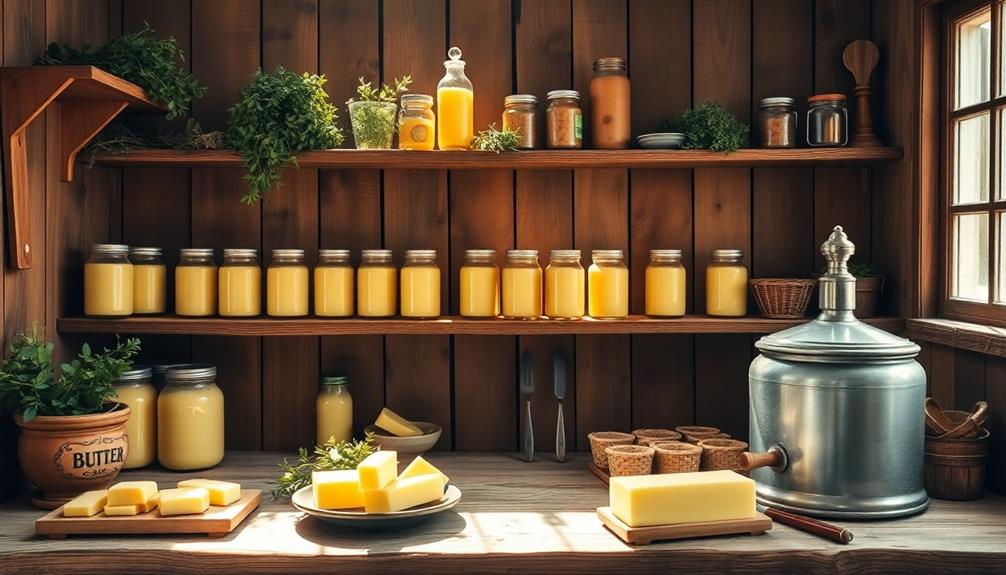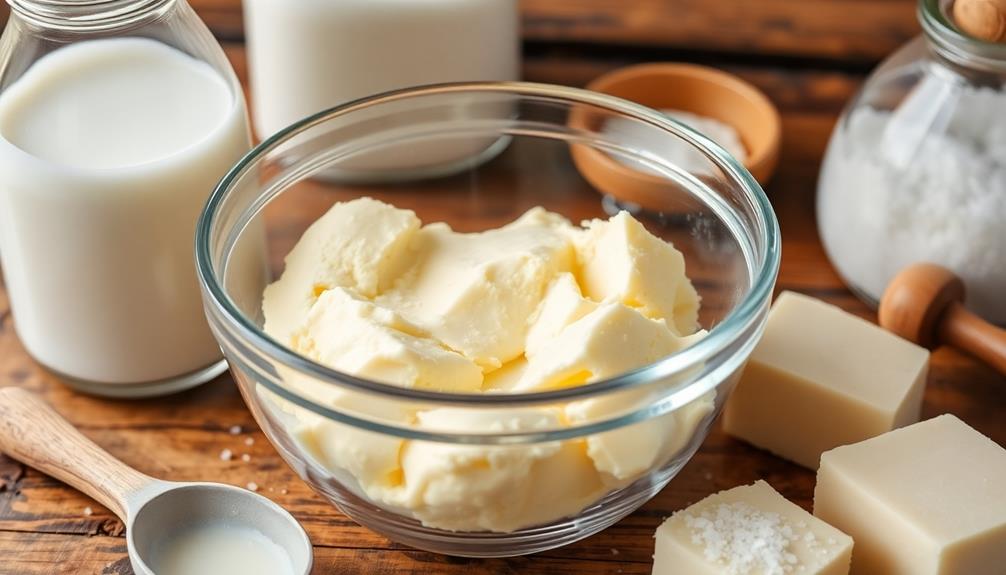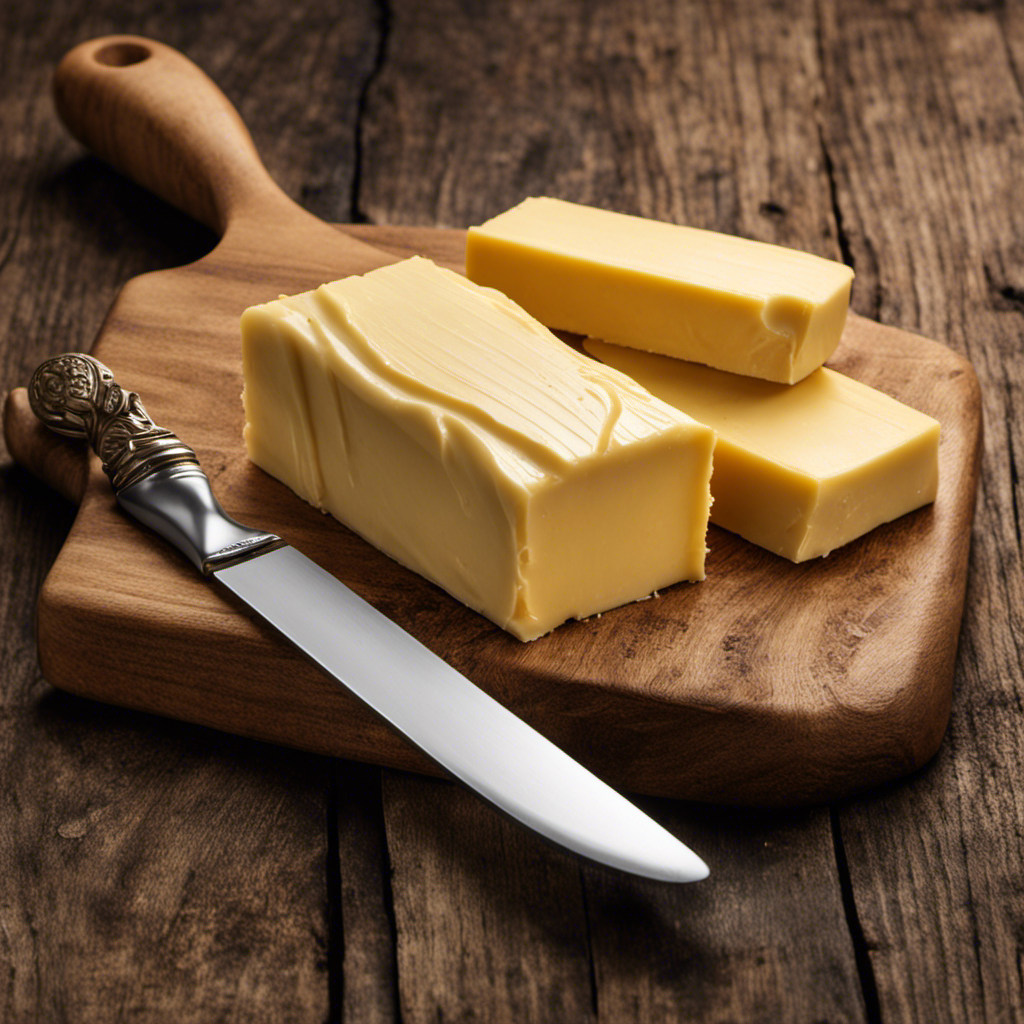Standing before the dairy section, contemplating my options for breakfast, my attention is captured by a modest, inconspicuous item: a chunk of butter. A fundamental component in countless dishes, it leaves me curious—what is the price of a chunk of butter?
In this article, we will delve into the fascinating history of butter pricing, explore the different sizes of butter nobs, and uncover the factors that affect the cost of this creamy delight.
Get ready to butter up your knowledge!
Key Takeaways
- Butter pricing has historically fluctuated due to factors such as supply and demand, weather conditions, government regulations, and consumer preferences.
- Understanding the different sizes of butter nobs (pat, tablespoon, stick, pound) can help determine how much to use in recipes.
- Butter is typically higher in price compared to margarine, but it offers a rich flavor, natural ingredients, and essential nutrients.
- Butter prices vary across different brands based on production methods, quality of ingredients, and market forces.
The History of Butter Pricing
You’ll be interested to learn about the history of butter pricing. Butter pricing trends have fluctuated over the years, reflecting changes in supply and demand, as well as economic factors. Historical butter prices have seen significant variations, influenced by factors such as weather conditions, government regulations, and consumer preferences.
In the early 1900s, butter prices were relatively stable due to a steady supply of milk and a lack of major disruptions in the industry. However, during the Great Depression in the 1930s, butter prices plummeted as people struggled financially and demand decreased.
Fast forward to the 1970s and 1980s, and butter prices soared due to a shortage of milk caused by bad weather and increased costs of production. In recent years, butter prices have remained relatively high due to increased demand for natural and organic food products.
Understanding the history of butter pricing can provide valuable insights into the factors that have shaped the industry and influenced the cost of this beloved dairy product.
Understanding the Different Sizes of Butter Nobs
Understanding the different sizes of butter nobs can help you determine how much to use in your recipes. It’s important to know how much butter you’re adding to your dishes, especially if you’re watching your butter consumption.
Here are four common sizes of butter nobs and their approximate measurements:
-
Pat of Butter: This is the smallest size of butter nob, usually weighing around one teaspoon or 4 grams.
-
Tablespoon of Butter: This is a commonly used size, equivalent to about 14 grams or half an ounce.
-
Stick of Butter: A stick of butter typically weighs around 113 grams or 4 ounces. It is divided into tablespoon-sized markings, making it easy to measure.
-
Pound of Butter: This is the largest size, weighing approximately 454 grams or 16 ounces.
Understanding these sizes can help you accurately measure and control your butter usage, ensuring the perfect balance in your recipes. So, next time you’re reaching for the butter, keep these measurements in mind to achieve culinary perfection!
Factors That Affect the Cost of Butter
When it comes to understanding the factors that affect the cost of butter, there are a few key points that cannot be overlooked.
First and foremost, supply and demand plays a major role in determining the price of butter in the market.
Additionally, the quality of the butter and the sourcing of the ingredients used in its production also have a significant impact on its cost.
Supply and Demand
If you’re wondering about the price of a nob of butter, it all comes down to supply and demand. Here’s a breakdown of how these factors affect the cost:
-
Butter shortage: If there is a shortage of butter due to low milk production or other factors, the price will increase as demand outweighs supply.
-
Increased demand: As more people choose to cook and bake at home, the demand for butter rises. This can lead to higher prices as manufacturers struggle to keep up with the increased demand.
-
Butter alternatives: When the price of butter goes up, consumers may turn to alternatives such as margarine or spreads made from vegetable oils. This can impact the demand for butter and potentially lead to price fluctuations.
-
Seasonal variations: Butter prices can also fluctuate depending on the season. During the holiday season, for example, the demand for butter may increase, leading to higher prices.
Understanding the dynamics of supply and demand is key to understanding why the price of a nob of butter can vary.
Quality and Sourcing
To ensure you’re getting a high-quality product, it’s important to consider the sourcing and production methods used in the making of your preferred spread. Butter sourcing plays a crucial role in determining the overall quality of the butter you consume.
When it comes to butter quality control, it starts with the selection of the right raw materials. The best butter is made from the milk of well-nourished cows that graze on natural pastures. The sourcing of the milk is vital, ensuring it comes from reputable farms that prioritize animal welfare and sustainable farming practices.
Additionally, butter quality control involves rigorous testing and inspection throughout the production process to guarantee freshness, taste, and texture. By understanding the butter sourcing and quality control practices, you can make informed choices and enjoy a delicious and reliable butter experience.
Price Comparison: Butter Vs. Margarine
The price of butter is typically higher compared to margarine. However, when it comes to taste and health benefits, butter is in a league of its own. Here’s why:
-
Rich Flavor: Butter has a creamy, indulgent taste that adds depth to any dish. Margarine, on the other hand, often lacks this distinctive flavor.
-
Natural Ingredients: Butter is made from churned cream, while margarine is typically a blend of vegetable oils. The natural ingredients in butter contribute to its rich taste and texture.
-
Health Benefits: While margarine may be lower in saturated fats, it often contains trans fats, which are linked to heart disease. Butter, when consumed in moderation, provides essential nutrients like vitamins A, D, E, and K.
-
Versatility: Butter can be used in cooking, baking, and spreading on toast. Its versatility makes it a staple in many kitchens.
How Butter Prices Vary Across Different Brands
Prices for different brands of butter vary depending on factors such as production methods and quality of ingredients. When it comes to butter brand comparison, there are a few key aspects to consider.
First, the production method can greatly impact the price. Some brands may use traditional methods, such as churning cream, while others may opt for modern, industrial processes.
Additionally, the quality of ingredients used can also play a role. Brands that use high-quality, organic ingredients may charge a higher price.
Another factor to consider is the butter price index, which takes into account the cost of production, distribution, and marketing.
Overall, it’s important to do some research and read reviews to find the perfect butter brand that suits your taste and budget.
The Relationship Between Butter Quality and Price
When considering the relationship between butter quality and price, it’s important to take into account factors like production methods and ingredients used. The quality of butter can greatly influence its price, and understanding this correlation is crucial for consumers. Here are four key points to consider:
-
Production methods: Butter made from organic or grass-fed milk tends to be of higher quality and therefore, can be priced higher.
-
Ingredients used: Butter made from high-quality cream and minimal additives will often command a higher price due to its superior taste and texture.
-
Origin and brand reputation: Butters sourced from renowned dairy regions or reputable brands often come with a premium price tag.
-
Butter pricing history: Historical trends and market demand can also impact butter prices, especially during times of scarcity or increased production costs.
Exploring Regional Differences in Butter Pricing
If you’re curious about butter pricing variations across different regions, it’s interesting to explore the factors that contribute to these differences. One of the main factors is regional butter production. Different regions have varying levels of butter production, which can affect the availability and pricing of butter. Additionally, consumer preferences play a role in determining butter prices. Some regions may have a higher demand for certain types or brands of butter, which can drive up prices. To illustrate this point, consider the following table:
| Region | Butter Production | Consumer Preferences |
|---|---|---|
| A | High | Organic, Grass-fed |
| B | Low | Local, Artisanal |
| C | Medium | Affordable, Bulk |
In Region A, where butter production is high and consumer preferences lean towards organic and grass-fed options, the prices for these types of butter may be higher compared to other regions. In Region B, where butter production is low but consumers prefer local and artisanal options, prices may be higher due to limited supply. In Region C, where butter production is medium and consumer preferences focus on affordability and bulk purchases, butter prices may be more competitive. These regional variations in butter pricing highlight the importance of both production capabilities and consumer demand in determining market prices.
The Impact of Supply and Demand on Butter Costs
In my previous discussion, I examined the regional differences in butter pricing. Now, let’s delve into the fascinating world of the butter market and how supply and demand can impact its costs. Here are four key factors to consider:
-
Seasonal fluctuations: Butter production is influenced by factors like weather, which can affect the availability and prices of butter throughout the year.
-
Changing consumer preferences: Consumer behavior plays a significant role in determining butter costs. If there is a sudden surge in demand for butter due to a new food trend or a popular recipe, prices may increase.
-
Global trade dynamics: The butter market is not limited to a single region. International trade, tariffs, and the exchange rate can all influence butter prices.
-
Supply chain disruptions: Any disruptions in the butter supply chain, such as transportation issues or labor shortages, can lead to shortages and subsequently drive up prices.
Understanding these factors gives us a glimpse into the intricate workings of the butter market and how consumer behavior can impact its costs.
Butter Price Fluctuations: Seasonal and Market Trends
Throughout the year, butter prices can fluctuate due to seasonal changes and market trends. It’s important for consumers to understand the factors that influence the price of butter, as it can impact their grocery budget. One key aspect of butter price analysis is the seasonal butter demand. During the holiday season and colder months, the demand for butter tends to increase as people bake more and indulge in holiday treats. This higher demand can result in higher prices. On the other hand, during warmer months, the demand for butter may decrease, leading to lower prices. To illustrate this, here is a table showcasing the average price of butter in different seasons:
| Season | Average Butter Price |
|---|---|
| Winter | $4.50 |
| Spring | $3.75 |
| Summer | $3.25 |
| Fall | $3.50 |
Understanding the seasonal fluctuations in butter prices can help consumers plan their shopping and budget accordingly.
The Economics of Butter Production and Pricing
You should be aware of the economics behind butter production and pricing. The process of producing butter has a significant environmental impact, which affects its overall cost. Additionally, government subsidies play a crucial role in determining butter prices. Here are four key points to understand:
-
Environmental Impact: Butter production involves large-scale dairy farming, which requires vast amounts of land, water, and feed for cattle. This leads to deforestation, water pollution, and greenhouse gas emissions.
-
Production Costs: The cost of producing butter includes expenses such as animal feed, labor, and equipment. These costs can vary depending on factors like feed prices and labor wages.
-
Market Demand: Butter prices are influenced by consumer demand. If there is high demand, prices may increase due to limited supply. Conversely, if demand decreases, prices may decrease as well.
-
Government Subsidies: Governments often provide financial assistance to dairy farmers, which helps stabilize butter prices. These subsidies can offset production costs and ensure a steady supply of butter.
Understanding the economics behind butter production and pricing is crucial for consumers and producers alike. It sheds light on the environmental impact and government involvement in this essential commodity.
Tips for Saving Money on Butter Purchases
One way to save money on purchasing butter is by looking for sales and discounts at your local grocery store. It’s always a good idea to keep an eye out for promotions or special deals on butter, as this can significantly reduce your grocery bill. Additionally, consider exploring butter alternatives or making homemade butter yourself. Not only can this be a fun and rewarding activity, but it can also save you money in the long run. By making your own butter, you have control over the ingredients, ensuring a healthier and more cost-effective option. Plus, you can experiment with different flavors and add-ins to customize your butter to your liking. Below is a table showcasing some popular butter alternatives and a few homemade butter recipes to get you started:
| Butter Alternatives | Homemade Butter Recipes |
|---|---|
| Margarine | Whipped Butter |
| Coconut Oil | Garlic Herb Butter |
| Olive Oil | Honey Cinnamon Butter |
| Avocado | Maple Pecan Butter |
| Nut Butters (e.g. Almond, cashew) | Chive and Parmesan Butter |
Frequently Asked Questions
Where Can I Buy Butter?
I can help you find butter locally. There are many places where you can buy it, like grocery stores or farmers markets. If you prefer online shopping, you can also find the best brands of butter available.
How Do I Store Butter to Keep It Fresh?
To keep butter fresh, store it in an airtight container in the refrigerator. It can stay fresh for up to a month. Remember to use a clean utensil each time you scoop it out to prevent contamination.
Can I Use Margarine as a Substitute for Butter in Baking?
As a baker, I’ve often wondered if I can use margarine as a substitute for butter. The butter vs margarine debate is ongoing, but I find that in baking, nothing beats the rich flavor of real butter.
How Does the Price of Butter Compare to Other Dairy Products?
When comparing the price of butter to other dairy products, it’s important to consider the nutritional value as well. Butter may be more expensive, but its rich flavor and versatility make it worth the investment.
Are There Any Health Benefits to Consuming Butter?
Butter, the golden elixir of deliciousness, is often compared to its counterpart, margarine. While margarine may have its benefits, butter reigns supreme in taste and nutrition when enjoyed in moderation as part of a balanced diet.
Conclusion
After diving deep into the world of butter pricing and understanding the factors that affect its cost, I am left in awe of the intricate economics behind this creamy delight.
It’s fascinating to see how supply and demand, seasonal trends, and market fluctuations all play a role in determining the price of a simple nob of butter.
Just like the unpredictable twists and turns of life, the cost of butter can take us on a rollercoaster ride.
So, next time you spread that golden goodness on your toast, remember the complex journey it took to reach your plate.









